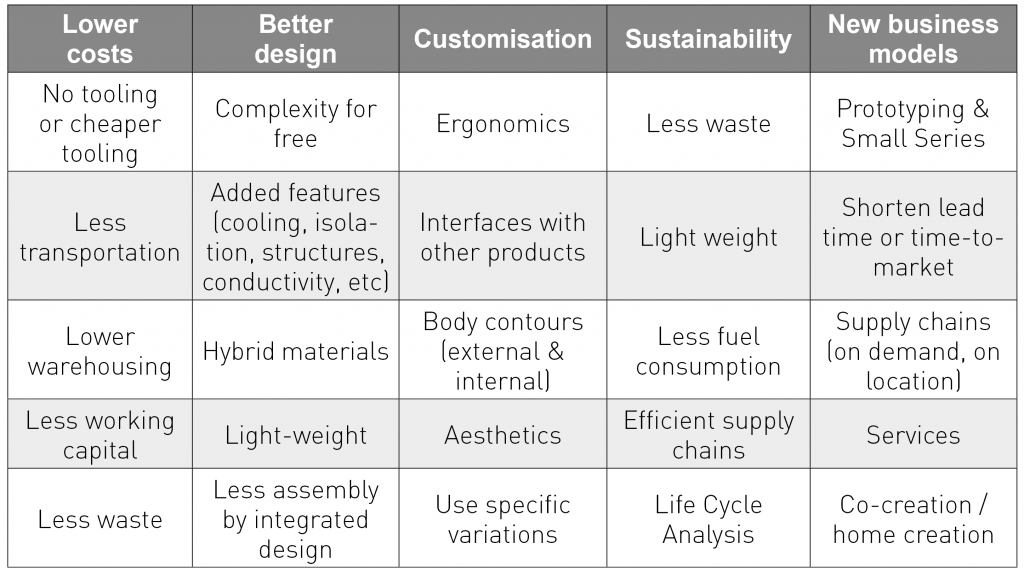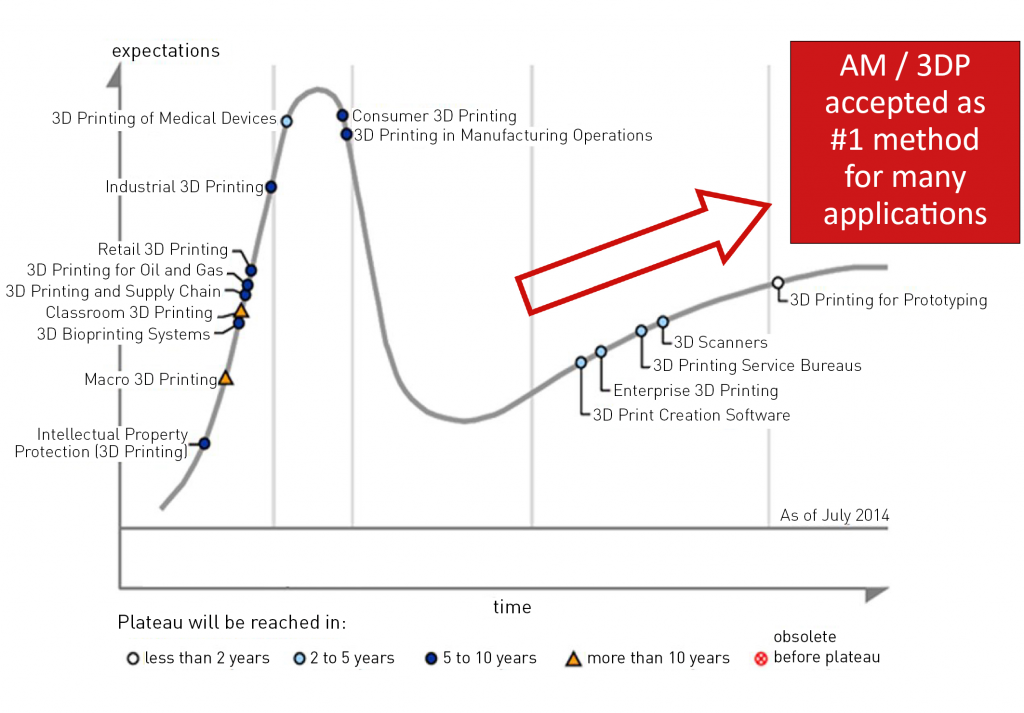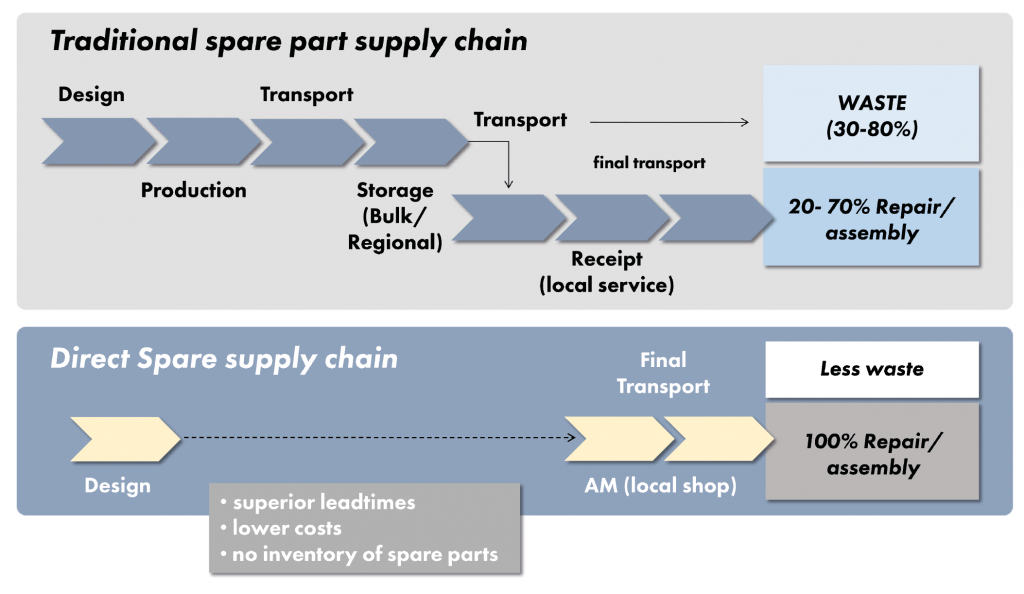To invest or not to invest: Understanding the business cases for entering the Additive Manufacturing arena
With such intense levels of interest in Additive Manufacturing, the pressure for businesses to adopt the technology can be high. Expectations, however, need to be managed and the business opportunities and challenges need to be understood. As Onno Ponfoort and Chris Krampitz explain, the dilemmas for any company looking to move into this arena range from fully understanding the advantages that the technology presents to ensuring that those tasked with the project, as well as potential customers, have the necessary technical training. [First published in Metal AM Vol. 1 No. 3, Autumn 2015 | 10 minute read | View on Issuu | Download PDF]

Additive Manufacturing is at the heart of the digital manufacturing revolution. Being able to produce individualised, tailored products, on demand and on location, spurs the imagination of everyone, children and adults, the technologically savvy and business professionals alike. But is the impact of AM indeed as great as some reports may suggest? This article looks at the potential impact of AM on the various stages in the value chain. It also addresses some key areas of development that need to be tackled before more wide spread use of AM can be expected.
Big promises
The technology holds a number of promises for industry. Making use of the layer-by-layer production method that the different AM techniques have in common allows for complex forms and improved designs previously unthinkable. When describing the benefits this can bring there are generally five categories of advantages given (Fig. 1).
Lower costs
AM supports the manufacturing of parts directly from the digital file (CAD/CAM) without having to manufacture a mould or die to form the part, or cut the part from a solid block of material as in milling.
When AM machines are sited at or near the location of use of the parts, transportation costs can be reduced. Clearly, the materials to be used in the AM machine (powder, wire etc.) need to be on-site, so some transportation costs will still be incurred. The ability for local and on demand production may also help minimise the number of parts held in stock, reducing warehouse space needed. Any of these aspects can lead to a decrease in capital required.
Better design
‘Complexity for free’ is a phrase used to indicate the fact that more complex designs can be produced without adding further production costs. An AM machine produces the desired parts layer-by-layer, adding material where needed. This allows for new shapes and forms, for example manifolds with channels situated to optimally cool during production or prostheses with surface structures to stimulate bone grow-in. Topology optimisation allows for an optimal balance between material used and structural requirements to be met.
Customisation
Conventionally, customised or individualised products are either hard to produce or very expensive. Personalised tools or prostheses perfectly matching the individual body contours, for example, are often impossible to manufacture or take many hours of design and handcrafting to produce. Small series of parts or products are often too expensive to produce, as the costs for an expensive mould need to be amortised over a small number of parts, making the final product too expensive to sell.
Additive Manufacturing allows the production of complex, individual parts, making customisation economically viable in a number of applications.
Sustainability
The initial thoughts people have when thinking about AM and sustainability have to do with the additive nature of the production method. Instead of taking away material with methods like milling or cutting, thereby producing waste, AM only uses the material required to produce the part. This is not entirely true, as often support structures are required to print a part, which are removed and discarded during finishing. Often, a like-for-like comparison of the energy used to produce one part via AM versus traditional manufacturing can be unfavourable for AM.
On the other hand, significant benefits can be found by producing lightweight components in the aerospace and automotive sectors, with for example a positive effect on the fuel consumption of an aircraft. Typically a ‘life cycle analysis’ is required to determine the actual environmental benefit of AM over traditional manufacturing techniques.
New business models
Additive Manufacturing certainly allows for shorter time to market. Design, engineering and prototyping can benefit from greatly reduced time frames. Concurrent engineering offers possibilities to execute different design strategies next to each other, ultimately leading to a more optimal end result. The potential for smaller series, increased customisation and local production already allows for new, distributed manufacturing models to be used and ways in which local SME’s are able to compete with global industrials in previously unthought-of ways will be created.
A number of these promises may not be too far-fetched or that far away. The Gartner Hype Cycle (Fig. 2) indicates a number of Additive Manufacturing related technologies and innovations and their readiness for use. Whereas some applications might still take some time or are uncertain to be achieved, such as the wide acceptance of consumer home printing of functional products, a number of innovations are already becoming mainstream. AM for prototyping is today one of the preferred methods used by industry and the number of service bureaus where you can have designs printed and finished is increasing dramatically. 3D scanning and 3D creation software are on the rise offering possibilities to quickly adjust standard designs to individual needs.

Investing in AM: A manufacturer’s dilemma
With all these benefits, why is industry not jumping on the AM bandwagon more forcefully? Unfortunately some barriers still exist. On the one hand, technological advances are still required with regards to size and speed. The building envelope of metal parts is still somewhat limited, particularly in relation to metal powder based processes, and build speed is limited. This means that rapid prototyping is possible, building one piece or small series is viable, but the mass production of parts is still some way off.
Another aspect to mitigate is the uncertainty of many industrialists with regards to AM. Metal AM machines require a substantial investment and the immediate need for these machines is not felt by all manufacturers. Combined with the tendency of industrial companies to shy away from outsourcing production activities they normally view as their own competence, investments in AM are often postponed. This is, in our opinion, a wrong choice as it means that these companies are starting to fall behind those already pursuing AM. In view of the rise in the number of service providers, we fortunately see this trend reversing.
Another uncertainty is the aspect of meeting quality and safety standards in an environment where industry norms and standards for AM have not been agreed upon by bodies such as ASTM and ISO. Questions such as: How can I reap the benefits of the AM technology and ensure that products meet standards and regulations? How will I secure that parts will be accepted by my customers? Will insurers underwrite my business and evaluate the risk exposure as acceptable? are realistic.
No review of the dilemmas facing the industry would be complete without considering education. AM requires a new way of thinking about design, engineering and doing business, when you want to use the technology to the fullest. Currently no comprehensive and all-encompassing curriculums are available, neither in regular education (schools, universities) nor as a form of continuous education for machine operators or craftsmen.
Even though the dilemmas described are realistic and challenges remain, waiting to enter the fray is, in our view, not an option.
Product development and design
The most important aspect for product development and design is the form freedom that AM gives when designing a part or product. Better design can lead to performance breakthroughs and product solutions that were simply not possible before. To make the most of these possibilities, new design principles and analysis tools are needed to support rapid prototyping and rapid testing.
Traditionally designers have been educated to “design for production”, making sure that the product designed can indeed be produced and post processed using the manufacturing method selected. This often leads to limitations in the design possibilities. AM allows for “design for function” with fewer manufacturing constraints. Using simulation software, early design verification is also possible.
AM requires less labour and supports faster production. It allows for the integration of parts with fewer assembly steps, something not always possible with existing technologies. AM will therefore lead, and in a growing number of cases already leads to, better solutions and better performance, lower costs, shorter lead time and reduced time to market. To reap these benefits, engineers, designers and their clients need to have an open mind to product design and discuss the requirements of the product rather than being inflexible about specifications. Often alternate designs, other materials or new production methods can meet demands.
Production efficiency
AM allows for small series production via the direct manufacture of parts. The possibility to integrate a number of parts from an assembly into the design, thus producing products with fewer parts, brings many benefits. There are fewer parts to order, there is less assembly and less risk during build-up, all of which can improve quality. In many cases it can also lead to time savings, energy savings and process improvements. An example of this part integration can be seen in the Havells – LayerWise case study overleaf. These are just some indications of the possibilities to lower costs and realise timing benefits with AM, compared to the existing production setup.
Making optimal use of AM for production efficiency means taking a fresh look at the make or buy decision. Often the AM machine required is not owned by the traditional supplier, or the knowledge about the production process and requirements is not available with your regular supply chain partner.
Supply chain
On demand and on location production are catchphrases often used when discussing the benefits of AM. On a larger geo-political scale, government officials even talk about reshoring manufacturing, with all the macro-economic benefits associated with that. When more mature and further developed, AM could indeed lead to lower stocks, distributed manufacturing and local production of spare parts. Ultimately this would mean faster repair, less scrap, cost savings and environmental benefits.
In reality this might be a bridge too far for now. A project that compared an AM supported supply chain to a traditional supply chain route gave interesting results (Fig. 3). It was hoped that AM would allow the production of parts on demand, when and where required. But the ‘dream situation’ depicted was unable to achieve this for the particular parts selected. The component could be printed, but the cost of developing a new AM specific design file, the qualification procedure for the alternative material required to print, and administrative aspects of registering a new part prevented AM from being an economically viable solution to print the part.

In other situations, however, those extra costs could be absorbed and lead to a positive business case. For instance, when a ship with perishable cargo has to wait for a part to be sent from far away and thus cannot sail for three weeks, the economics are completely different. The cost of losing the cargo can, most of the time, easily be offset by spending some thousand euros on the design and Additive Manufacturing of a spare part, even if just a temporary one. These situations ask for an integral view of the business case, instead of a part versus part comparison.
Reaping the benefits
Additive Manufacturing is often regarded as a disruptive technology. We do not support this view, but see AM as an additional tool in the toolbox of industry. In some cases AM will be the preferred way of working, in other cases AM supports the shorter time to market for new products that are designed using AM, but produced using traditional manufacturing methods. In other cases AM offers a temporary solution, to bridge the time between the breakdown of a part and the arrival of the original spare.
In any case the use of AM will grow. In the near future many more materials will be available to print. Both metals and polymers will be offered with characteristics meeting customer demand. Ceramics and bio-materials will also find their way to mainstream AM.
Initially, as in every developing market, actors in the industry perform a wide variety of activities for many customer groups in diverse industries. When the market grows, and the demand becomes more specified, it is impossible to satisfy the need of every customer with a one-size-fits-all solution. Smart companies already active in the AM industry, or newcomers, dare to focus on a specific niche in the market. The success factors you need to meet for a client in the B2C arena requiring an enabling service differ considerably from the success factors of a surgeon asking for a prosthesis.
The AM industry is rapidly maturing. Both equipment and material manufacturers and the companies they serve understand that industry standards need to be met, using safe and secure tools and machines, operated by qualified personnel. By-standers will soon become laggards, as developments move fast. But for those hopping on the AM train soon, there is still plenty of space to help lead the industry to higher grounds.
Authors
Onno Ponfoort
Practice Leader 3D Printing at Berenschot Consulting, based in Utrecht, the Netherlands. He has been active in the field of AM since 2002, published many articles and wrote the first book on business impact of AM in 2014: Successful Business Models for 3D Printing.
Chris Krampitz
Director Strategy Digital Manufacturing at UL Inc., based in Northbrook IL, USA. He has over 20 years of experience innovating manufacturing technologies and materials, and is the driving force behind the comprehensive AM Training Curriculum UL has developed recently.







